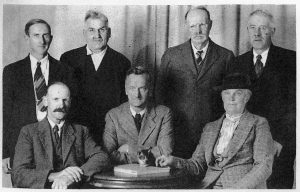Women and Okanagan-Shuswap Dairies
Laura Rose, author and dairy instructor at Ontario Agricultural College in the early 1900s believed that the operation of dairies should be women’s work. Marjorie Cohen (1984) reviewed the decline of women’s participation in the dairy industry primarily in Eastern Canada and concluded that: “While women remained in dairying in the expanding pre-industrial stage, they did not manage to develop large-scale capitalist enterprises as the activity moved from household craft production to more capital-intensive factory production. Instead, women’s work in dairying tended to remain labour-intensive and confined to what could be performed within the household (p. 334)”.
Government funding, industry organizations, and education became dominated by men, who were usually the landowners as dairies became large scale and capital intensive.[i] This was certainly evident in the Shuswap Okanagan Dairy Industry Co-operative Association (S.O.D.I.C.A.). In their forty-year history, Alice Craster was the only woman who served on their Board of Directors.

1939 Board of Directors Back row: D. Jones, J.R. Freeze, J. McCallan, J. Gillian. Front: S. Halksworth, R. Peters, Mrs. A. S. Craster.
Alice Craster was born Alice Owen Wilson in Shropshire in 1874, the daughter of Rev. and Mrs. Wilson of Church Stratton. She was an accomplished musician who studied violin with Sir Edward Elgar and an artist who specialized in animal paintings and sketches. Edward Craster had established a horse ranch near Boise Idaho in the 1890s and in 1905 returned briefly to England. There, he married Alice and left for the Chilcotin area of British Columbia. After a brief stay in the Chilcotin, they moved to the Okanagan, purchased land at Lavington and established “Cwmdale Jersey Farm.” They purchased their jersey cows in Washington State, shipped them to Okanagan landing and walked them out to Lavington.
The Crasters had six sons and two daughters. Edward Craster became ill and bedridden in 1924 and died in 1930. Alice became highly respected in the dairy industry and worked as a Jersey cattle buyer throughout the United States for P. Burns and Company. She was a member of the Vernon Symphony Orchestra. “Cwmdale” was sold in 1952 and Alice died in Vernon in 1958.
Alice Craster’s son Dick summed up his mother’s zest for life: “My mother was a remarkable woman; anything she did was successful for her, yet she shunned publicity.”[ii]. Her story brings to mind another woman in the dairy industry in the Shuswap area. D Dutchmen Dairy in Sicamous was founded in 1978 by Chris and Nellie Dewitt (dutchmendairy.ca). When Chris died in 1988, Nellie and her children continued to operate the dairy, well-known today for being an environmentally friendly, family operation with some of the best ice cream around.
Is it possible that women are now reclaiming the dairy industry? Are there other BC dairies owned and operated by women?
[i] Cohen, Marjorie Griffin (1984). The Decline of Women In Canadian Dairying, Social History, 17(34), 307-334.
[ii] Wamboldt, Beryl (1965). The History of S.O.D.I.C.A. Vernon, BC: The Vernon News, p. 151.

